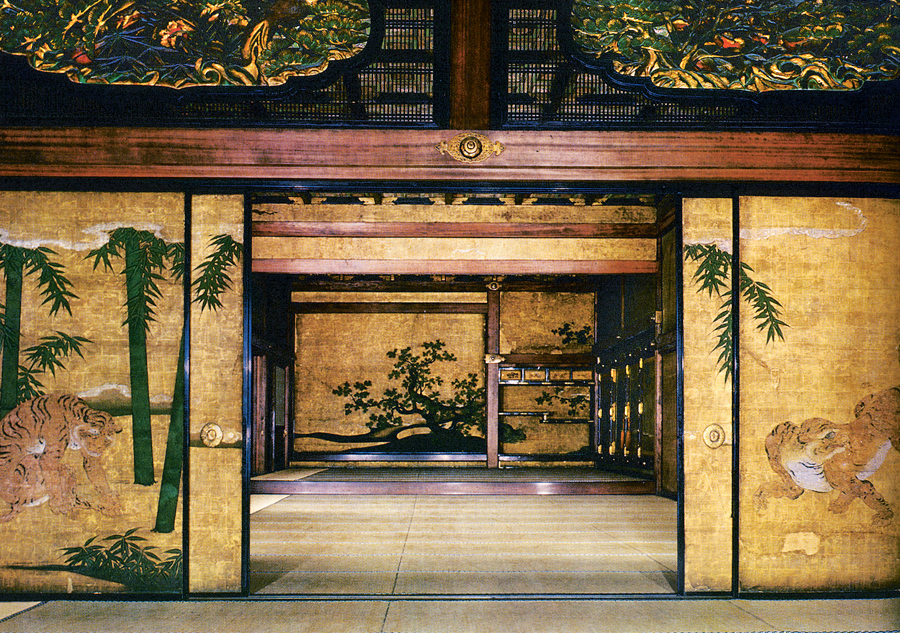A History of World Societies:
Printed Page 633
A History of World Societies Value
Edition: Printed Page 639
Chapter Chronology
Commercialization and the Growth of Towns
During the civil war period, warfare seems to have promoted social and economic change, much as it had in China during the Warring States Period (403–221 B.C.E.). Trade grew, and greater use was made of coins imported from Ming China. Markets began appearing at river crossings, at the entrances to temples and shrines, and at other places where people congregated. Towns and cities sprang up all around the country, some of them around the new castles. Traders and artisans dealing in a specific product — such as comb makers, sesame oil producers, or metalworkers — began forming guilds. Money-lending was a very profitable business — annual interest rates reached 300 percent. In Kyoto the powerful monastery Enryakuji licensed the moneylenders, in essence running a lucrative protection racket. Foreign trade also flourished, despite chronic problems with pirates who raided the Japanese, Korean, and Chinese coasts (see pages “Piracy and Japan’s Overseas Adventures”).
Recent scholarship demonstrates that the Tokugawa era witnessed the foundations of modern Japanese capitalism: the development of a cash economy, the use of money to make more money, the accumulation of large amounts of capital for investment in factory or technological enterprises, the growth of business ventures operating over a national network of roads, and the expansion of wage labor. That these developments occurred simultaneously with, but entirely independent of, similar changes in Europe fascinates and challenges historians.
In most cities, merchant families with special privileges from the government controlled the urban economy. Frequently, a particular family dominated the trade in a particular product and then branched out into other businesses. The family of Kōnoike Shinroku is an example. In 1600 he established a sake (SAH-kay) brewery in the village of Kōnoike (sake is an alcoholic beverage made from fermented rice). By 1604 he had opened a branch office in Edo, and in 1615 he opened an office in Osaka and began shipping taxes paid in rice from western Japan to Osaka. In 1656 one of Shinroku’s sons founded a banking or money-changing business in Osaka. Forty years later the Kōnoike family was doing business in thirty-two daimyo domains. Eventually, the Kōnoike banking house made loans to and handled the tax-rice for 110 daimyo families. In 1705, with the interest paid from daimyo loans, the Kōnoike bought a tract of ponds and swampland, turned the land into rice paddies, and settled 480 households on the land. (Land reclamation under merchant supervision became a typical feature of Tokugawa business practices.) Involved by this time in five or six business enterprises, the house of Kōnoike had come a long way from brewing sake.

Interior of Nijo Castle To assert control over the imperial court and the city of Kyoto, Tokugawa Ieyasu built palace-like Nijo Castle there in 1601–1603. He had the sliding doors painted by leading artists of the period, making the castle as elegant as the imperial palace. (From Fujioka Michio, Genshoku Nihon no Bijutsu, Vol. 12: Shiro to Shoin [Tokyo: Shogakkan, 1968]/Visual Connection Archive)
Japanese merchant families also devised distinct patterns and procedures for their business operations. What today is called “family-style management principles” determined the age of apprenticeship (between eleven and thirteen); the employee’s detachment from past social relations and adherence to the norms of a particular family business; salaries; seniority as the basis of promotion, although job performance at the middle rungs determined who reached the higher ranks; and the time for retirement. All employees in a family business were expected to practice frugality, resourcefulness, self-denial, and careful accounting. These values formed the basis of what has been called the Japanese “industrious revolution.” They help to explain how, after the Meiji (MAY-jee) Restoration of 1867 (see “The Meiji Restoration” in Chapter 26), Japan was able to industrialize rapidly and compete successfully with the West. (In both Japan and China there was a market for books giving advice on how to get ahead. See “Viewpoints 21.2: Chinese and Japanese Financial Advice.”)
In the seventeenth century underemployed farmers and samurai, not to mention the ambitious and adventurous, thronged to the cities. As a result, Japan’s cities grew tremendously. Kyoto became the center for the manufacture of luxury goods like lacquer, brocade, and fine porcelain. Osaka was the chief market, especially for rice. Edo was a center of consumption by the daimyo, their vassals, and government bureaucrats. Both Osaka and Edo reached about a million residents.
Two hundred fifty towns came into being in this period. Most ranged in size from 3,000 to 20,000 people, but a few, such as Hiroshima, Kagoshima, and Nagoya, had populations of between 65,000 and 100,000. In addition, perhaps two hundred towns along the main road to Edo emerged to meet the needs of men traveling on the alternate residence system. In the eighteenth century perhaps 4 million people, 15 percent of the Japanese population, resided in cities or towns.
